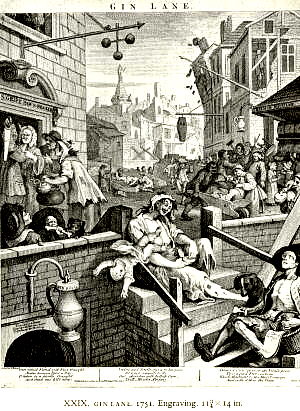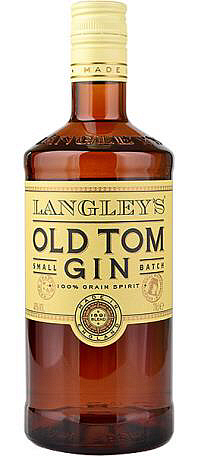

|
 Gin is a white distilled spirit, typically 40% alcohol, made from a fermented mash of grain flavoured with a mix of herbal 'botanicals' based on juniper berries. The favourings are generally trade secrets, but may include anise, angelica, orris, licorice, cinnamon, coriander and cassia.  The dissolute 'Gin Lane' in Hogarth's 1751 print The name almost certainly derives from 'jenever', the Dutch word for 'juniper'. John Kersey's 'Universal English Dictionary' of 1706 defines 'Geneva' as "a kind of strong Water so called." but doesn't mention 'gin'. The shortened form is known at least since Bernard Mandeville, he of the famous poem about economics 'Fable of the Bees', in an essay on Gin of about 1714; "Nothing is more destructive, either in regard to the health, or the vigilance and industry of the poor, than the infamous liquor, the name of which, derived from Juniper in Dutch, is now by frequent use and the laconic spirit of the nation, from a word of middling length shrunk into a monosyllable, intoxicating gin."  'Old Tom' is an old-fashioned sweet gin Image: http://www.drinksdirect.co.uk/ London Gin is the original 'dry' gin, while Plymouth Gin is more fruity and aromatic. 'Old Tom' was a sweetened gin popular in the 19th Century, it is now only rarely available. It appears that the flavouring of spirits with juniper started out as just a good way to hide the sickly-sweet, taste of the propyl and butyl alcohols produced alongside ethyl 'drinking' alcohol in crude pot-still distillation. The technique is generally taken to have originated in the Netherlands and become popular after the invasion, or 'Glorious Revolution' of 1688 displaced King James II of England put the Dutch William of Orange on the English throne. Gin provided a convenient alternative to brandy at a time of conflict with France so that, between 1689 and 1697, assorted legal measures, notably the breaking of the London Guild of Distillers monopoly in 1690, encouraged its manufacture. So began the 'Gin Craze' of the early 18th Century famously illustrated in William Hogarth's 1751 engravings of the dissolute 'Gin Lane' and its healthier neighbour 'Beer Street'. By 1736 things had gone too far, the epidemic of binge drinking provoked a moral outrage and a legislative backlash which might well be compared to the modern drug wars. Five Gin Acts were passed between 1729 and 1751 designed to control the consumption of the spirit known as 'Blue Lightning', 'Cholic-and-Gripe-Waters', 'Cock-my-Cap', 'Cuckolds Comfort', 'Kill-Grief', 'Ladies Delight', 'Last Shift', 'Madam Geneva', 'Makeshift', 'My Ladys Eye-water', 'Royal Poverty', 'Sangree', 'Tom Row' and even 'King Theodore of Corsica'. The 1830's invention by Irishman Aeneas Coffey of the "column still" allowed delightfully pure ethyl alcohol to be manufactured in quantity, leading to the non-sweet 'dry' gins of today, though the drink has never quite shaken off its sleazy image, with disreputable bars still being called 'gin-mills', drunks referred to as 'gin-sodden' and even the best of gins being known as 'mother's ruin'. In 2004 the British Government removed gin from the list of household staples used to calculate retail prices. See also: Whisky Gin and Tonic Beech Gin Colchester Oysters Gooseberry Champagne Mahogany Norfolk Punch Pimm's No 1 Cup Sloe Gin  2013  |
|
MORE FROM Foods of England... Cookbooks ● Diary ● Index ● Magic Menu ● Random ● Really English? ● Timeline ● Donate ● English Service ● Food Map of England ● Lost Foods ● Accompaniments ● Biscuits ● Breads ● Cakes and Scones ● Cheeses ● Classic Meals ● Curry Dishes ● Dairy ● Drinks ● Egg Dishes ● Fish ● Fruit ● Fruits & Vegetables ● Game & Offal ● Meat & Meat Dishes ● Pastries and Pies ● Pot Meals ● Poultry ● Preserves & Jams ● Puddings & Sweets ● Sauces and Spicery ● Sausages ● Scones ● Soups ● Sweets and Toffee ● About ... ● Bookshop ● Email: [email protected] COPYRIGHT and ALL RIGHTS RESERVED: © Glyn Hughes 2022 BUILT WITH WHIMBERRY |